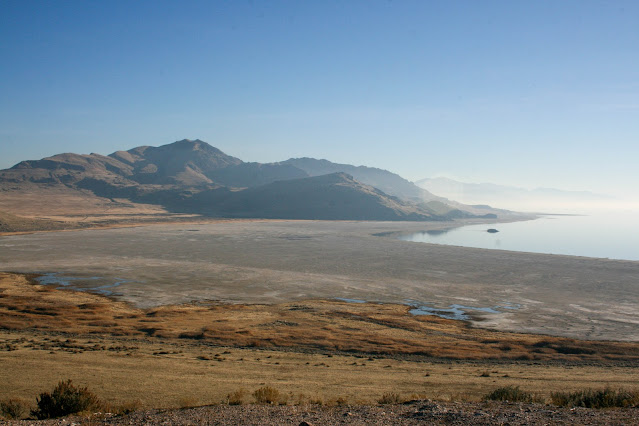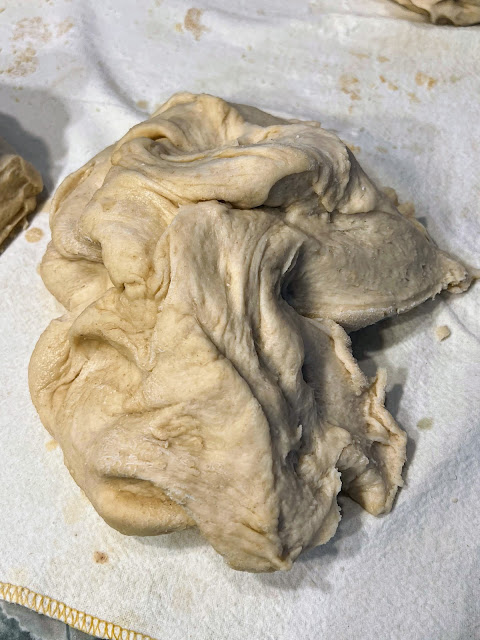Monday, February 28, 2022
Migratory Tundra Swans
I guess I never thought about swans as migratory birds. They always seemed to me to something out of folk tales and special places. One of my earliest memories is of the swan boats in the Public Garden in Boston, Massachusetts. It was a surprise to see all these swans in the Farmington Bay Waterfowl Management Area next to the Great Salt Lake in Utah. It is hard to see without zooming in on the photo, but these are probably Tundra Swans or Cygnus columbianus because of the yellow markings on their bills. Here is a close up of one of the swans showing the yellow markings on its bill.
Saturday, February 26, 2022
Farmington Bay, Great Salt Lake, Utah
The ice on the marsh was just beginning to melt from the winter cold but the air was as clear as it gets, and the sky was as clear and blue as it is possible to be. This is a view of the famous (to bird watchers) Farmington Bay Waterfowl Management Area. It is a freshwater bay along the east side of the Great Salt Lake in Utah. The area is featured on dozens of birding websites. There are a lot of birds in this photo but you would need a very long lens to see them.
Friday, February 25, 2022
Foraging for Food
Thursday, February 24, 2022
The Wasatch Front from Farmington Bay, Great Salt Lake, Utah
The Wasatch Front is a dramatic mountain range that runs north and south along the east side of a series of large valleys. Farmington Bay is a large freshwater drainage from the rivers and streams of mountains to the east. This whole area is part of the Great Basin that does not have drainage out to the oceans. In prehistoric times, the whole area was a giant lake called Lake Bonneville.
Wednesday, February 23, 2022
Ghost Mountains over Farmington Bay, Great Salt Lake, Utah
It was an absolutely clear day at Farmington Bay on the Great Salt Lake in Utah. These are the Oquirrh Mountains about fifty miles away. You get this kind of view in Utah.
Monday, February 21, 2022
Pheasant
Pheasants are found all over the world but here is a Wikipedia article explaining that they are mostly an introduced species.
Pheasants (/ˈfɛzənt/) are birds of several genera within the family Phasianidae in the order Galliformes. Although they can be found all over the world in introduced (and captive) populations, the pheasant genera native range is restricted to Eurasia. The classification "pheasant" is paraphyletic, as birds referred to as pheasants are included within both the subfamilies Phasianinae and Pavoninae, and in many cases are more closely related to smaller phasianids, grouse, and turkey (formerly classified in Perdicinae, Tetraoninae, and Meleagridinae) than to other pheasants.
I have seen several of these birds in Utah. This one, however, was stuffed and in the George S. and Dolores Doré Eccles Wildlife Education Center at Farmington Bay on the Great Salt Lake. I did take a number of remarkable photos of other birds in the wild which I will share in the future.
Wednesday, February 16, 2022
Tafoni in the Honeycomb Hills, Utah
The holes in these rocks are called tafoni. Here is an explanation of them from the Wikipedia: Tafoni.
Tafoni often occur in groups that can riddle a hillside, cliff, or other rock formation. They typically develop in siliceous, either coarse-grained (sandstone) or coarsely crystalline (granite) rock types. They also have been observed in lacustrine silts, tuffs, and conglomerates. They can be found in all climate types, but are most prolific in salt-rich environments, such as deserts and coastal zones. They have been found across the Earth, with dramatic forms found in the Jodhpur-Ajmer section of India's Thar Desert, Petra, Jordan, Coastal California and Australia, and even in the Arctic regions, and Antarctica. The common factors in the environments in which they are found are high salt concentrations and frequent or occasional desiccating conditions.
These rocks are in a small mountain range in the West Desert of Utah called the Honeycomb Hills.
Tuesday, February 15, 2022
Roots of Knowledge Stained Glass, Utah Valley University, Orem, Utah
You will have to click on this image to see the details. This is the Roots of Knowledge Stained Glass mural at Utah Valley University in Orem, Utah. It is well worth the visit. If you want to know about this huge stained-glass project see: https://www.uvu.edu/rootsofknowledge/
Monday, February 14, 2022
The harbor in Annapolis, Maryland
After living most of my life in the deserts of Arizona and Utah, I appreciate water and love to see boats. We kayaked for years while in Arizona and love the water but now, it is not easy or convenient to get to a lake or river.
Saturday, February 12, 2022
A Curly Prickly Pear
February is the end of the "Winter" in the low desert. Temperatures start to climb in March and April. The cactus start blooming at the end of February and various varieties bloom until June. It is getting hard to remember the heat of the summer here on the mountainside in Utah.
Friday, February 11, 2022
Yucca
There are lots of different plant species. Here is a brief explanation about these interesting and beautiful plants from Wikipedia: Yucca.
Yucca is a genus of perennial shrubs and trees in the family Asparagaceae, subfamily Agavoideae. Its 40–50 species are notable for their rosettes of evergreen, tough, sword-shaped leaves and large terminal panicles of white or whitish flowers. They are native to the hot and dry (arid) parts of the Americas and the Caribbean.Early reports of the species were confused with the cassava (Manihot esculenta). Consequently, Linnaeus mistakenly derived the generic name from the Taíno word for the latter, yuca. The Aztecs living in Mexico since before Spanish arrival, in Nahuatl, call the local yucca species (Yucca gigantea) iczotl, which gave the Spanish izote.Izote is also used for Yucca filifera.
These plants are the Boyce Thompson Arboretum near Superior, Arizona.
Wednesday, February 9, 2022
Antelope Island, Great Salt Lake, Utah
There are several smaller mountain ranges that form the edges of the Great Salt Lake in Utah. When the water level is high enough, they form islands. One of the most prominent of these is Antelope Island on the southeast side of the lake. Presently, Antelope Island is technically not an island. Years of drought have lowered the water level to the point that the island is now solidly connected to the shoreline.
Tuesday, February 8, 2022
Provo, Utah from the Shoreline Trail
This is a view looking southwest from the Shoreline Trail up above Provo, Utah. It is an amazingly clear day. You can see Utah Lake in the background as well as The East Tintic Mountains in the far west and the closest mountains are the West Mountains.
Monday, February 7, 2022
Looking North on the Shoreline Trail, Provo, Utah
It is amazing to walk along the Shoreline Trail with this extensive view of Utah Valley. The trail follows the ancient shoreline of a huge prehistoric lake called Lake Bonneville. You can take a short walk or hike for endless miles. The whole trail is separated in segments that are loosely connected so you might have to walk through a subdivision or find your way across a freeway in order to hike the entire length.
Saturday, February 5, 2022
Provo, Utah from the Shoreline Trail
We live right next to the mountains and only have to walk or drive a few minutes to the trail heads of the Shoreline Trail. On clear days, the views are majestic. The trail is mostly almost level with a few steep stretches. In the middle of the winter, it is not busy at all. You can see the clouds over Mount Timpanogos in the background. The large buildings you can see are Missionary Training Center of The Church of Jesus Christ of Latter-day Saints, next to the Brigham Young University Campus. You can also see the Provo, Utah Temple is you look closely. The trail winds around and we live about a block or so from one part of the trail.
Thursday, February 3, 2022
Homemade Bread
One of the most beautiful things that come out of our kitchen is homemade bread. This is one of the stages of making a wonderful loaf of bread. I liked the shape and texture also.
Wednesday, February 2, 2022
A Winter Walk on the Shoreline Trail, Utah Valley, Utah
The Shoreline Trail stretches for miles along the Wasatch Front. This section is south of the large "Y" on Y Mountain above Provo, Utah. It is a lovely place to walk and enjoy the grand vista of the valley below. The trail is just about at the 6000-foot level and on this day, it was partially sunny but very cold.

















